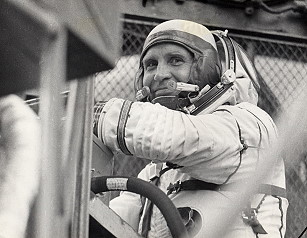Human Orbital Spaceflights
![]()
International Flight No. 74Soyuz T-3MayakUSSR |
![]()
Launch, orbit and landing data
walkout photo |
 |
|||||||||||||||||||||||
alternative crew photo |
alternative crew photo |
|||||||||||||||||||||||
alternative crew photo |
alternative crew photo |
|||||||||||||||||||||||
original crew photo |
alternative crew photo |
|||||||||||||||||||||||
Crew
| No. | Surname | Given names | Position | Flight No. | Duration | Orbits | |
| 1 | Kizim | Leonid Denisovich | Commander | 1 | 12d 19h 07m 42s | 204 | |
| 2 | Makarov | Oleg Grigoriyevich | Flight Engineer | 3 | 12d 19h 07m 42s | 204 | |
| 3 | Strekalov | Gennadi Mikhailovich | Research Cosmonaut | 1 | 12d 19h 07m 42s | 204 |
Crew seating arrangement
|
 |
|
||||||||||||||||
Backup Crew
| No. | Surname | Given names | Position | |
| 1 | Lazarev | Vasili Grigoriyevich | Commander | |
| 2 | Savinykh | Viktor Petrovich | Flight Engineer | |
| 3 | Polyakov | Valeri Vladimirovich | Research Cosmonaut |
Hardware
| Launch vehicle: | Soyuz-U (No. Zh15000-202) |
| Spacecraft: | Soyuz T-3 (7K-ST No. 8L) |
Flight
|
Launch from the Baikonur Cosmodrome and
landing 130 km east of Dzheskasgan. Originally Konstantin Feoktistov was assigned for this mission but was grounded a few days prior launch due to medical problems. The Soyuz-T was a major upgrade over previous Soyuz spacecraft, sporting solid-state electronics for the first time and a much more advanced onboard computer to help overcome the chronic docking problems that affected cosmonauts during space station missions. In addition, solar panels returned, allowing the Soyuz-T to fly up to 11 days independently as well as a redesigned propulsion system. Finally, it could at last carry three cosmonauts with pressure suits. Following a one-day solo flight Soyuz T-3 docked with the Salyut 6 space station on November 28, 1980. Soyuz T-3 was the first Soviet mission with three cosmonauts on board since 1971. Part of their mission was to further test the Soyuz-T. Main goals of the mission were overhauling and reactivating of the space station. Maintenance work on the station was also done. The crew conducted the Mikroklimat experiment to assess the station's living conditions, and began work on the thermal control system. They also installed a new hydraulic unit with four pumps, replaced electronics in the Salyut 6 telemetry system, repaired electrical system faults and replaced computer in the onboard control system. During their brief stay on Salyut 6, they performed the usual experiments using the Splav and Kristall units, and studied “biological objects” they brought with them in Soyuz-T 3. They used the Svetoblok and Oazis units. Much of their time, however, was devoted to space station maintenance. The crew had to work on scientific experiments including holografic record of photographies, experiments on the fields of Earth observation, medicine, materials science and biology, using a so called "greenhouse", which was the most interesting part for the media. On December 8, 1980 Progress 11 carried out an orbit correction for the complex. The Soyuz spacecraft is composed of three elements attached end-to-end - the Orbital Module, the Descent Module and the Instrumentation/Propulsion Module. The crew occupied the central element, the Descent Module. The other two modules are jettisoned prior to re-entry. They burn up in the atmosphere, so only the Descent Module returned to Earth. The deorbit burn lasted about 3 to 4 minutes. Having shed two-thirds of its mass, the Soyuz reached Entry Interface - a point 400,000 feet (121.9 kilometers) above the Earth, where friction due to the thickening atmosphere began to heat its outer surfaces. With only 23 minutes left before it lands on the grassy plains of central Asia, attention in the module turned to slowing its rate of descent. Eight minutes later, the spacecraft was streaking through the sky at a rate of 755 feet (230 meters) per second. Before it touched down, its speed slowed to only 5 feet (1.5 meter) per second, and it lands at an even lower speed than that. Several onboard features ensure that the vehicle and crew land safely and in relative comfort. Four parachutes, deployed 15 minutes before landing, dramatically slowed the vehicle's rate of descent. Two pilot parachutes were the first to be released, and a drogue chute attached to the second one followed immediately after. The drogue, measuring 24 square meters (258 square feet) in area, slowed the rate of descent from 755 feet (230 meters) per second to 262 feet (80 meters) per second. The main parachute was the last to emerge. It is the largest chute, with a surface area of 10,764 square feet (1,000 square meters). Its harnesses shifted the vehicle's attitude to a 30-degree angle relative to the ground, dissipating heat, and then shifted it again to a straight vertical descent prior to landing. The main chute slowed the Soyuz to a descent rate of only 24 feet (7.3 meters) per second, which is still too fast for a comfortable landing. One second before touchdown, two sets of three small engines on the bottom of the vehicle fired, slowing the vehicle to soften the landing. |
Photos / Graphics
 |
 |
 |
 |
 |
 |
 |
 |
 |
 |
 |
| © |  |
Last update on April 04, 2021.  |
 |